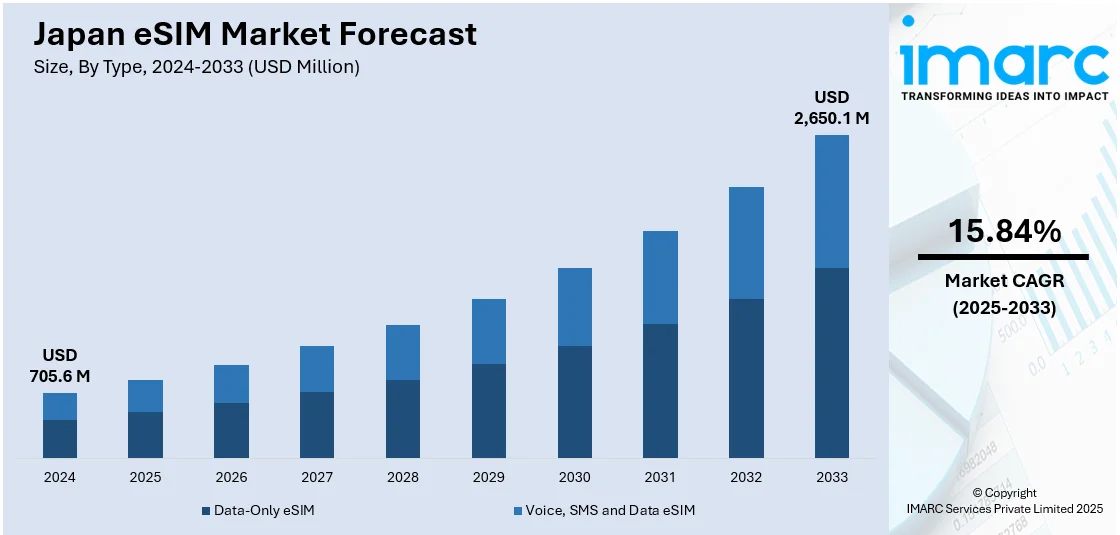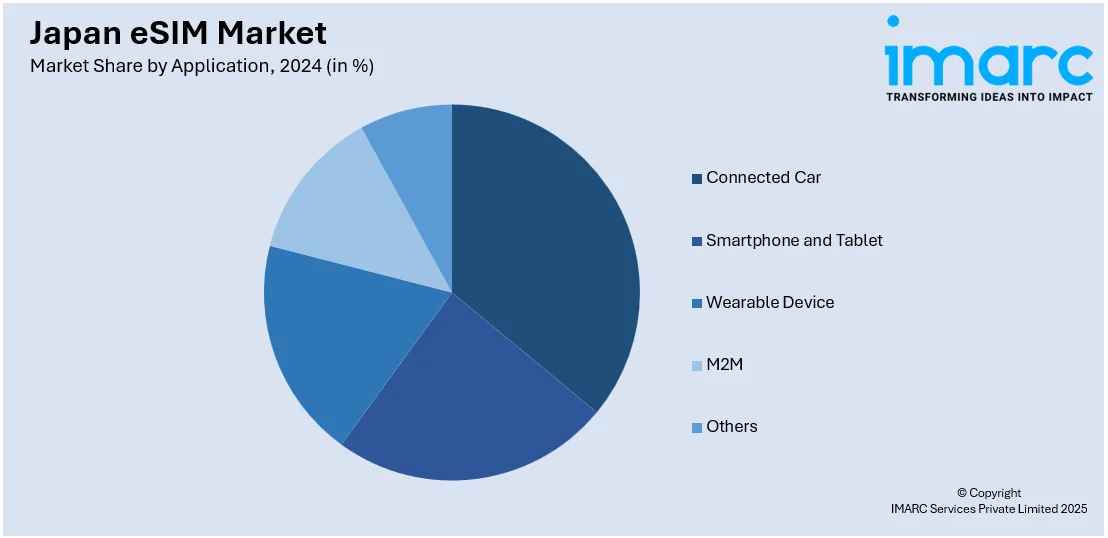
Japan eSIM Market Size, Share, Trends and Forecast by Type, Solution, Application, Vertical, and Region, 2025-2033
Japan eSIM Market Overview:
The Japan eSIM market size reached USD 705.6 Million in 2024. Looking forward, IMARC Group expects the market to reach USD 2,650.1 Million by 2033, exhibiting a growth rate (CAGR) of 15.84% during 2025-2033. The market is fueled by the increasing use of eSIM technology across devices such as smartphones, wearables, and IoT applications, promoting seamless connectivity. The demand for travel eSIMs, providing affordable international roaming solutions, also fuels market growth.
|
Report Attribute
|
Key Statistics
|
|---|---|
|
Base Year
|
2024 |
|
Forecast Years
|
2025-2033
|
|
Historical Years
|
2019-2024
|
| Market Size in 2024 | USD 705.6 Million |
| Market Forecast in 2033 | USD 2,650.1 Million |
| Market Growth Rate 2025-2033 | 15.84% |
Japan eSIM Market Trends:
Consumer Electronics Expansion of eSIM
The Japan eSIM market share is rapidly rising with consumer electronics firms increasingly applying the technology across a wider range of devices, aside from smartphones. Tablets, laptops, and smartwatches are now mostly compatible with eSIMs, which provide seamless switching between networks and simplified device management for the users. Tech-savvy Japanese consumers appreciate the convenience of embedded SIMs, especially in an environment where digital mobility and simplicity are coveted. eSIMs obviate the use of physical SIM cards, resulting in devices that are sleeker and more streamlined—which in turn are desirable features for Japan's premium electronics market. With top local and international brands providing eSIM-enabled devices, customers can now enjoy greater access to multi-device connectivity on a single network plan. This increased integration also enables a broader shift toward 5G and always-connected environments. With greater compatibility and simplified onboarding by network providers, eSIM uptake is likely to further solidify Japan's leadership in consumer tech innovation.

Adoption in Automotive Industry and Integration of Smart Mobility
Japan's robust automotive sector is adopting eSIM technology to promote in-car connectivity and smart mobility experiences, which in turn fuels the Japan eSIM market growth. Car manufacturers are adding eSIMs to new vehicle models to enable real-time telematics, GPS navigation software updates, vehicle diagnostics, and OTA software updates. This enhances the driving experience while also allowing automakers to have direct connectivity with vehicles after sale. In urban centers, where smart city infrastructure is evolving, eSIM-powered cars can communicate more effectively with traffic systems, infrastructure, and cloud-based services. Japanese customers are also shifting toward connected vehicle options, including integrated Wi-Fi, remote diagnostics, and in-vehicle entertainment, all of which depend on strong embedded connectivity. The use of eSIMs aids in reducing complexity for car manufacturers through global coverage without requiring physically changing SIM cards. Hence, this trend is part of Japan's broader move toward environmentally friendly, technology-oriented transportation and welcomes autonomous and electric vehicle advancements.
eSIM Spread in IoT and Industrial Environments
Demand for eSIM in Japan is growing rapidly throughout the Internet of Things (IoT) and industrial industries. eSIMs are best suited for intelligent devices and sensors needing long-term, secure, and remote connectivity—like agriculture, healthcare, manufacturing, and smart infrastructure. In industry environments, eSIM technology allows machines to remain connected automatically, making maintenance, logistics, and system monitoring easier. For instance, utility devices and smart meters are able to employ eSIMs for the automatic transfer of data, minimizing the need for hands-on readings and allowing for real-time control over energy usage. Wearable medical devices also gain from eSIMs with the provision of uninterrupted connectivity for health monitoring without the necessity of continuous exposure to Wi-Fi. The remote provisioning feature of eSIMs is particularly advantageous in inhospitable or remote locations, aligning with Japan's vision of advanced industrial automation. Since the nation is at the forefront of IoT adoption, eSIM technology will continue to be a pillar of Japan's connected future in both public and private sectors, indicating a massive and positive shift in the Japan eSIM market outlook.
Japan eSIM Market Segmentation:
IMARC Group provides an analysis of the key trends in each segment of the market, along with forecasts at the regional level for 2025-2033. Our report has categorized the market based on type, solution, application, and vertical.
Type Insights:
- Data-Only eSIM
- Voice, SMS and Data eSIM
The report has provided a detailed breakup and analysis of the market based on the type. This includes data-only eSIM; and voice, SMS and data eSIM.
Solution Insights:
- Hardware
- Connectivity Services
The report has provided a detailed breakup and analysis of the market based on the solution. This includes hardware and connectivity services.
Application Insights:

- Connected Car
- Smartphone and Tablet
- Wearable Device
- M2M
- Others
The report has provided a detailed breakup and analysis of the market based on the application. This includes connected car, smartphone and tablet, wearable device, M2M, and others.
Vertical Insights:
- Automotive
- Consumer Electronics
- Manufacturing
- Telecommunication
- Transportation and Logistics
- Others
The report has provided a detailed breakup and analysis of the market based on the vertical. This includes automotive, consumer electronics, manufacturing, telecommunication, transportation and logistics, and others.
Regional Insights:
- Kanto Region
- Kansai/Kinki Region
- Central /Chubu Region
- Kyushu-Okinawa Region
- Tohoku Region
- Chugoku Region
- Hokkaido Region
- Shikoku Region
The report has also provided a comprehensive analysis of all the major regional markets, which include Kanto Region, Kansai/Kinki Region, Central /Chubu Region, Kyushu-Okinawa Region, Tohoku Region, Chugoku Region, Hokkaido Region, and Shikoku Region.
Competitive Landscape:
The market research report has also provided a comprehensive analysis of the competitive landscape. Competitive analysis such as market structure, key player positioning, top winning strategies, competitive dashboard, and company evaluation quadrant has been covered in the report. Also, detailed profiles of all major companies have been provided.
Japan eSIM Market News:
- In January 2024, NTT Communications Corporation (NTT Com), the ICT solutions and international communications division of the NTT group, revealed that it will start commercial sales of its Active Multi-access SIM which has been available on a trial basis since March 28, 2023, commencing on January 31. The updated SIM and related service will allow various IoT devices to transition between a network's primary and secondary carriers during a network outage, providing network redundancy through a single SIM automatically, without requiring network supervision or manual switching at the device terminal. Mobile communication services for IoT, offered in Japan and worldwide, utilize eSIMs and have complete MVNO infrastructure.
- In September 2024, Ubigi, a worldwide cellular connectivity service provider, revealed the enhancement of its travel eSIM data plan offerings for Japan, now providing travelers with unlimited data plan options alongside the previously offered fixed data capacity plans. This launch represents an important milestone in Ubigi's goal to offer a greater range of affordable and convenient mobile internet data plans to travelers in one of Asia's top tourist spots.
Japan eSIM Market Report Coverage:
| Report Features | Details |
|---|---|
| Base Year of the Analysis | 2024 |
| Historical Period | 2019-2024 |
| Forecast Period | 2025-2033 |
| Units | Million USD |
| Scope of the Report | Exploration of Historical Trends and Market Outlook, Industry Catalysts and Challenges, Segment-Wise Historical and Future Market Assessment:
|
| Types Covered | Data-Only eSIM, Voice, SMS and Data eSIM |
| Solutions Covered | Hardware, Connectivity Services |
| Applications Covered | Connected Car, Smartphone and Tablet, Wearable Device, M2M, Others |
| Verticals Covered | Automotive, Consumer Electronics, Manufacturing, Telecommunication, Transportation and Logistics, Others |
| Regions Covered | Kanto Region, Kansai/Kinki Region, Central /Chubu Region, Kyushu-Okinawa Region, Tohoku Region, Chugoku Region, Hokkaido Region, Shikoku Region |
| Customization Scope | 10% Free Customization |
| Post-Sale Analyst Support | 10-12 Weeks |
| Delivery Format | PDF and Excel through Email (We can also provide the editable version of the report in PPT/Word format on special request) |
Key Questions Answered in This Report:
- How has the Japan eSIM market performed so far and how will it perform in the coming years?
- What is the breakup of the Japan eSIM market on the basis of type?
- What is the breakup of the Japan eSIM market on the basis of solution?
- What is the breakup of the Japan eSIM market on the basis of application?
- What is the breakup of the Japan eSIM market on the basis of vertical?
- What is the breakup of the Japan eSIM market on the basis of region?
- What are the various stages in the value chain of the Japan eSIM market?
- What are the key driving factors and challenges in the Japan eSIM market?
- What is the structure of the Japan eSIM market and who are the key players?
- What is the degree of competition in the Japan eSIM market?
Key Benefits for Stakeholders:
- IMARC’s industry report offers a comprehensive quantitative analysis of various market segments, historical and current market trends, market forecasts, and dynamics of the Japan eSIM market from 2019-2033.
- The research report provides the latest information on the market drivers, challenges, and opportunities in the Japan eSIM market.
- Porter's five forces analysis assist stakeholders in assessing the impact of new entrants, competitive rivalry, supplier power, buyer power, and the threat of substitution. It helps stakeholders to analyze the level of competition within the Japan eSIM industry and its attractiveness.
- Competitive landscape allows stakeholders to understand their competitive environment and provides an insight into the current positions of key players in the market.
Need more help?
- Speak to our experienced analysts for insights on the current market scenarios.
- Include additional segments and countries to customize the report as per your requirement.
- Gain an unparalleled competitive advantage in your domain by understanding how to utilize the report and positively impacting your operations and revenue.
- For further assistance, please connect with our analysts.
 Request Customization
Request Customization
 Speak to an Analyst
Speak to an Analyst
 Request Brochure
Request Brochure
 Inquire Before Buying
Inquire Before Buying




.webp)




.webp)












